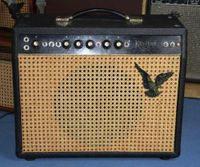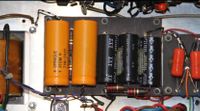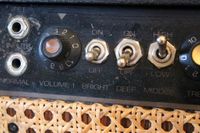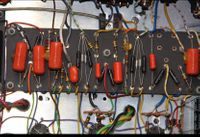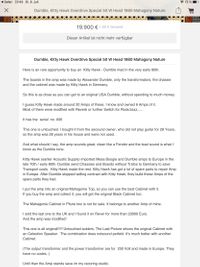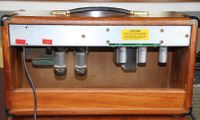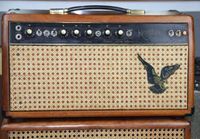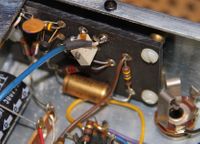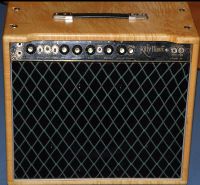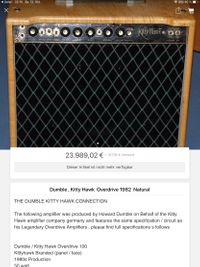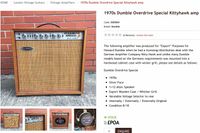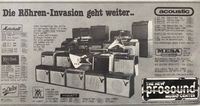Basicly there is a lot to say icl to read about the real Kitty Hawk Story and the Roy Brothers and the legend dumble kitty Hawk Amps and the follow Kitty Hawk Standard and Cutsom Super Amps . you know there is so many shit and confusion outside and on the Vintage Ampmarket so here we go ..........................
At the end of the 1970s, the Roy brothers operated a distribution for rare American boutique amplifiers in the Ruhr area, including models from Dumble and Mesa Boogie. Howard Alexander Dumble is now legendary, but was still completely unknown in our latitudes at the end of the 1970s. Thanks to the Roy brothers, a good dozen of his combos were exported to Germany. Supposedly in order to save customs duties, Dumble only sent the finished chassis without housing and speakers. These were manufactured in this country and finally came into circulation.
Thats a one of the maby 20 Dumble Hawks and have actually nothing to do with the following Standard or Custom amps to do. but still all the technik and Parts and wiering give the bace to the Standard and Cutsom Amps. This Amps going over 20 ooo Doller or Euro ive you find some but better play Lottery . Its a hgher chance to get 6 right nr and the jack pot than to find those Amps on the free Market even not at the huge Corona Desatser
These amps could easily be classified as real dumbles. I have heard and reviewed some of them over the past 20 years, and I have to say that they delivered 100% Dumble sounds despite the Made-In-Germany case. They also bore the usual inscription "Overdrive Special" and of course the name of the builder. These were still so-called Silverface models with 50 watts from two 6L6 tailpipes, not to be confused with the later 100 watt Blackface models as we know them from Larry Carlton or Robben Ford.
And as usual with most boutique amp manufacturers, the circuits and components used at Dumble were also quite variable. For practicing professionals, Dumble usually only built to order. And therefore practically no Dumble is like the other. Here and there there were minor changes to the circuit and components.
However, the small series that Dumble had built for the Roy brothers was relatively consistent. The amps visibly come from a batch and were basically constructed in the same way.
Most of these amps are still owned by some German guitarists or collectors and, like everything Dumble has built since then, are just as legendary as the reputation of the master himself.
I had three copies of these amps at home and was fascinated by how musical and stable these amps sounded. The sound culture clearly came from the Fender camp, only that the Dumbles made everything a little better than their famous role models. They sounded more dynamic, crisp, accented and somehow somewhat vocal and central than a good Fender amp.
A Nother giga rare Dumble Hawk as Top and 1x12er Cab sold over Reverb for 20 000 Euro ..
At some point there might be discrepancies. Apparently no one knows that exactly, and we don't want to speculate here. In any case, the first shipment from California apparently remained the last. After the first amps were sold out, the Roy brothers decided to found their own amp company that was given the sonorous name Kitty Hawk. As a result, today they also built very well-known and sometimes very sought-after boutique amplifiers, namely the Kitty Hawk Standard and the Junior. Lovers also certify these amps consistently of a tonal proximity to the famous model from California.
In parallel, around 12-20 amps were created around 1980, which are now known as Kitty Hawk Dumbles. It is unclear whether these amps were built during the production of the first Kitty Hawk standards or shortly before. In any case, these amplifiers are still completely freely wired and basically very precise copies of the described dozen that Dumble had delivered to Germany. I found it all the more interesting to find such a rare amplifier and take a closer look.
Our test subject has the serial number 014 and has no other model name apart from the name Kitty Hawk. Now the myth is around that Howard Alexander Dumble also built these amps, and the Roy brothers “only” the transformers, the chassis, the wiring, the tubes, the housing, the loudspeaker, the potentiometers, the switches and other things would have added anything missing. Already at the list you start to smile. There is always discussion that Dumble made the boards for these amps and shipped them to Germany to complete a Dumble amp. Could be natural, but who would want to call such an amp a Dumble because of a hardboard with maybe a few capacitors on it? No matter, we prefer to focus on the facts.
The fact is that the Testamp is based on the imported Silverface Overdrive Special models in terms of structure and circuitry. The component boards actually look exactly like those from the original Dumbles. Allen Bradley carbon press resistors and old Mallory / Sprague 6PS (polyester) capacitors were installed here. So far very authentic. The bias board, the FET board and the relay also seem to be from Dumble. The three toggle switches on the front for Bright On / Off, Deep On / Off and Low or High Mid were also modeled.
A Kitty Dubble Hawk in Classic Dumble Style sold for more than 24 ooo Euro .....
The chassis itself is reminiscent of the well-known Kitty Hawk design. The transformers are not - as with the Dumbles - from cannibalized Fender amps, but of unknown origin. Only the choke comes from Fender (or Schumacher). Now we know only too well how important the transformers are for the sound results in a tube amplifier. This is a huge cut in terms of the role model. You also miss the CTS pots, which may have been replaced by another make back then due to the scarcely available values.
Despite the proximity of the circuit to the original, the interior looks largely different from an amp soldered by Dumble himself. For example, very different cables were used, just as if the builder had used them from the volute, and also the layout is much messier and messier than the original. The output transformer sits a little too close to the amplifier input and is also installed slightly crooked. The speaker sockets and the socket for the foot switch are located below the chassis and not, as usual, on the back.
The overall impression is a bit sloppy compared to today's boutique amps or the originals from Dumble. But be it! What does one of these rare copies sound like?For a fair comparison, you would of course have to have an original on hand. Unfortunately I didn't have that. Therefore I can only judge from memory. The amp shown sounds very convincing in the clean channel. A slight hum of the network disturbs the overall picture, but that could be due to the age of the test person.
Basically, the basic sound is reminiscent of a good Fender Pro, Super Reverb or Bandmaster. However, the amplifier is much more stable and dynamic than the Fender models. In addition, it is so loud that you would assume almost 100 watts under the hood. That is all quite typical for this type of construction.
The tone control intervenes much more vehemently in the sound. The center control really reacts from very clear Fender-like scooped mids to a hearty middle claw, which made the Dumble sound so legendary. The switchable presence acts as if you could switch off the negative feedback. In the presence high position, the amplifier becomes much louder and brighter, in the low position quieter, warmer and rounder. The front switches also work in the manner of the prototype. The jazz / rock circuit chooses between a low fundamental or a brighter and somewhat more aggressive tuning, and the mid-switch between higher and lower mids.
If you switch on the overdrive department, you actually get this typical dumble crunch emphasized in the low mids. However, the sound is so concise and exposed here that the player really has to unpack all his skills to sound really good. This crunch tone sounds great in my opinion, but it requires a really controlled attack. Perhaps this is also the reason why Dumble himself later made the overdrive channel of his amps smoother and more compressed (so-called rubber monkey circuit). There is not much with smacky high-gain sounds à la ZEN drive pedal. You have to fight for every note, but then you are rewarded with a very dynamic sound.
It remains to be mentioned that the amp shown was equipped with a Celestion G12-100. However, the sound of this speaker is not that far away from the Electro Voice EVM12L that was favored by Dumble at the time. The Celestion looks good on the Kitty Hawk and can handle the enormous volume quite well.
But last not least Even if it may not seem so honorable to simply copy something, you have to concede to the Roy brothers that they recognized much earlier than the people of Dumble, for example, that these amps are really something special. Kitty Hawk Builders like the Roy Brothers leant a lot about Dumble so the start there own serei like the legend Standard or most better Cutsom Amp what they not have any to do with the Dumble Overdrive but its a Kitty Hak Dumble Sounding Amp i would say

